

Compact Muon Solenoid
LHC, CERN
| CMS-HIG-13-025 ; CERN-PH-EP-2014-239 | ||
| Searches for heavy Higgs bosons in two-Higgs-doublet models and for $ \mathrm{t \to ch } $ decay using multilepton and diphoton final states in pp collisions at 8 TeV | ||
| CMS Collaboration | ||
| 10 October 2014 | ||
| Phys. Rev. D 90 (2014) 112013 | ||
| Abstract: Searches are presented for heavy scalar ($\mathrm{H}$) and pseudoscalar ($\mathrm{A}$) Higgs bosons posited in the two doublet model (2HDM) extensions of the standard model (SM). These searches are based on a data sample of pp collisions collected with the CMS experiment at the LHC at a center-of-mass energy of $\sqrt{s}$ = 8 TeV and corresponding to an integrated luminosity of 19.5 fb$^{-1}$. The decays $\mathrm{H} \rightarrow \mathrm{h} \mathrm{h}$ and $\mathrm{A} \rightarrow \mathrm{Z} \mathrm{h}$, where $\mathrm{h}$ denotes an SM-like Higgs boson, lead to events with three or more isolated charged leptons or with a photon pair accompanied by one or more isolated leptons. The search results are presented in terms of the $\mathrm{H}$ and $\mathrm{A}$ production cross sections times branching fractions and are further interpreted in terms of 2HDM parameters. We place 95% CL cross section upper limits of approximately 7 pb on $\sigma \mathcal{B}$ for $\mathrm{H} \rightarrow \mathrm{h} \mathrm{h}$ and 2 pb for $\mathrm{A} \rightarrow \mathrm{Z} \mathrm{h}$. Also presented are the results of a search for the rare decay of the top quark that results in a charm quark and an SM Higgs boson, $\mathrm{t} \rightarrow \mathrm{c} \mathrm{h}$, the existence of which would indicate a nonzero flavor-changing Yukawa coupling of the top quark to the Higgs boson. We place a 95% CL upper limit of 0.56% on $\mathcal{B}(\mathrm{t} \rightarrow \mathrm{c} \mathrm{h})$. | ||
| Links: e-print arXiv:1410.2751 [hep-ex] (PDF) ; CDS record ; inSPIRE record ; Public twiki page ; CADI line (restricted) ; | ||
| Figures | |

png pdf |
Figure 1-a:
a: diphoton invariant mass distribution for $\gamma \gamma { {\tau }_\mathrm {h}} $ events with $ {E_{\mathrm {T}}^{\text {miss}}} <$ 30 GeV with an exponential fit derived from the 100--120 and 130--200 GeV sidebands regions. b: the same distribution for the $\gamma \gamma \ell $ events with $ {E_{\mathrm {T}}^{\text {miss}}} $ in 30--50 GeV range with an exponential fit (blue curve) where the exponent is fixed to the value obtained from the fit shown in the leftfigure. Also shown for comparison purposes is an actual fit (magenta curve) to the shown data distribution. An example signal distribution (in red), assuming $\sigma \mathcal {B}( {\mathrm {p}} {\mathrm {p}}\to {\mathrm {H}} \to {\mathrm {h}} {\mathrm {h}} )$ to be equal to three times 3.59 pb, as described in the text, shows that the signal is well-contained in the 120--130 GeV window. |

png pdf |
Figure 1-b:
a: diphoton invariant mass distribution for $\gamma \gamma { {\tau }_\mathrm {h}} $ events with $ {E_{\mathrm {T}}^{\text {miss}}} <$ 30 GeV with an exponential fit derived from the 100--120 and 130--200 GeV sidebands regions. b: the same distribution for the $\gamma \gamma \ell $ events with $ {E_{\mathrm {T}}^{\text {miss}}} $ in 30--50 GeV range with an exponential fit (blue curve) where the exponent is fixed to the value obtained from the fit shown in the leftfigure. Also shown for comparison purposes is an actual fit (magenta curve) to the shown data distribution. An example signal distribution (in red), assuming $\sigma \mathcal {B}( {\mathrm {p}} {\mathrm {p}}\to {\mathrm {H}} \to {\mathrm {h}} {\mathrm {h}} )$ to be equal to three times 3.59 pb, as described in the text, shows that the signal is well-contained in the 120--130 GeV window. |

png pdf |
Figure 2-a:
The $ {E_{\mathrm {T}}^{\text {miss}}} $ distributions for four-lepton events with an off-$ {\mathrm {Z}}$ OSSF1 dilepton pair, no $ {\mathrm {b}}$-tagged jet, and no $ { {\tau }_\mathrm {h}} $ (left), and one $ { {\tau }_\mathrm {h}} $(right). These non-resonant (off-$ {\mathrm {Z}}$) channels are sensitive to the $ {\mathrm {H}} \to {\mathrm {h}} {\mathrm {h}} $ signal which is shown stacked on top of the background distributions, assuming $\sigma \mathcal {B}( {\mathrm {p}} {\mathrm {p}}\to {\mathrm {H}} \to {\mathrm {h}} {\mathrm {h}} ) =$ 3.59 pb, as described in the text. |

png pdf |
Figure 2-b:
The $ {E_{\mathrm {T}}^{\text {miss}}} $ distributions for four-lepton events with an off-$ {\mathrm {Z}}$ OSSF1 dilepton pair, no $ {\mathrm {b}}$-tagged jet, and no $ { {\tau }_\mathrm {h}} $ (left), and one $ { {\tau }_\mathrm {h}} $(right). These non-resonant (off-$ {\mathrm {Z}}$) channels are sensitive to the $ {\mathrm {H}} \to {\mathrm {h}} {\mathrm {h}} $ signal which is shown stacked on top of the background distributions, assuming $\sigma \mathcal {B}( {\mathrm {p}} {\mathrm {p}}\to {\mathrm {H}} \to {\mathrm {h}} {\mathrm {h}} ) =$ 3.59 pb, as described in the text. |

png pdf |
Figure 3-a:
The $ {E_{\mathrm {T}}^{\text {miss}}} $ distributions for four-lepton events without $ {\mathrm {b}}$-tagged jets which contain an on-$ {\mathrm {Z}}$ OSSF1 dilepton pair and one $ { {\tau }_\mathrm {h}} $ (a), and an OSSF2 dilepton pairs with one $ {\mathrm {Z}}$ candidate and no $ { {\tau }_\mathrm {h}} $ (b). These resonant (containing a $ {\mathrm {Z}}$) channels are sensitive to the $ {\mathrm {A}} \to {\mathrm {Z}} {\mathrm {h}} $ signal which is shown stacked on top of the background distributions, assuming $\sigma \mathcal {B}( {\mathrm {p}} {\mathrm {p}}\to {\mathrm {A}} \to {\mathrm {Z}} {\mathrm {h}} ) =$ 3.59 pb, as described in the text. |
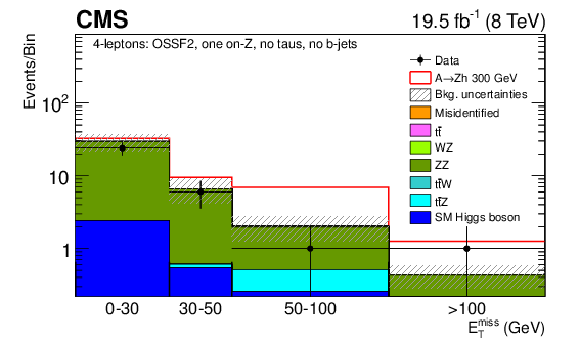
png pdf |
Figure 3-b:
The $ {E_{\mathrm {T}}^{\text {miss}}} $ distributions for four-lepton events without $ {\mathrm {b}}$-tagged jets which contain an on-$ {\mathrm {Z}}$ OSSF1 dilepton pair and one $ { {\tau }_\mathrm {h}} $ (a), and an OSSF2 dilepton pairs with one $ {\mathrm {Z}}$ candidate and no $ { {\tau }_\mathrm {h}} $ (b). These resonant (containing a $ {\mathrm {Z}}$) channels are sensitive to the $ {\mathrm {A}} \to {\mathrm {Z}} {\mathrm {h}} $ signal which is shown stacked on top of the background distributions, assuming $\sigma \mathcal {B}( {\mathrm {p}} {\mathrm {p}}\to {\mathrm {A}} \to {\mathrm {Z}} {\mathrm {h}} ) =$ 3.59 pb, as described in the text. |
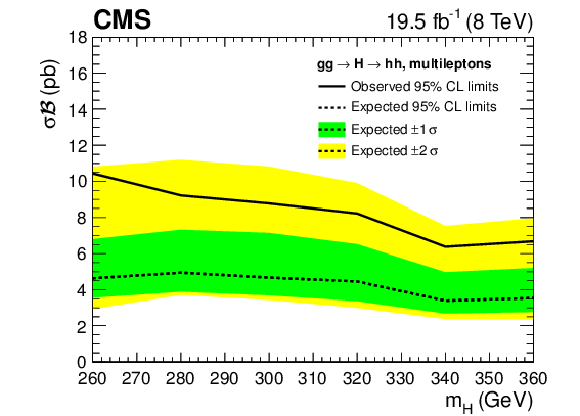
png pdf |
Figure 4-a:
a: observed and expected 95% CL $\sigma \mathcal {B}$ limits for gluon fusion production of $ {\mathrm {H}} $ and the decay $ {\mathrm {H}} \to {\mathrm {h}} {\mathrm {h}} $ with one and two standard deviation bands shown. These limits are based only on multilepton channels. The $ {\mathrm {h}} $ branching fractions are assumed to have SM values. b: the same, but also including lepton+diphoton channels. |

png pdf |
Figure 4-b:
a: observed and expected 95% CL $\sigma \mathcal {B}$ limits for gluon fusion production of $ {\mathrm {H}} $ and the decay $ {\mathrm {H}} \to {\mathrm {h}} {\mathrm {h}} $ with one and two standard deviation bands shown. These limits are based only on multilepton channels. The $ {\mathrm {h}} $ branching fractions are assumed to have SM values. b: the same, but also including lepton+diphoton channels. |

png pdf |
Figure 5-a:
a: observed and expected 95% CL $\sigma \mathcal {B}$ limits for gluon fusion production of $ {\mathrm {A}} $ and the decay $ {\mathrm {A}} \to {\mathrm {Z}} {\mathrm {h}} $ with one and two standard deviation bands shown. These limits are based only on multilepton channels. The $ {\mathrm {h}} $ branching fraction are assumed to have SM values. b: the same, but also including lepton+diphoton channels. |
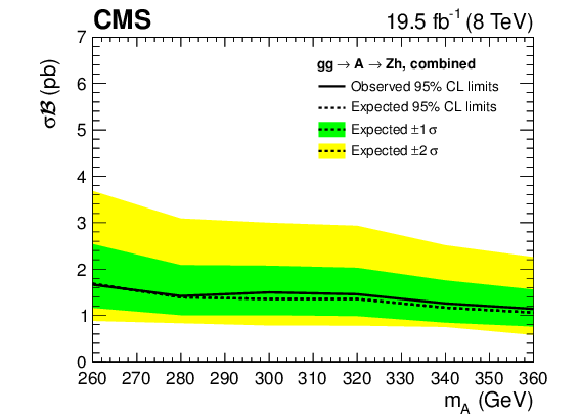
png pdf |
Figure 5-b:
a: observed and expected 95% CL $\sigma \mathcal {B}$ limits for gluon fusion production of $ {\mathrm {A}} $ and the decay $ {\mathrm {A}} \to {\mathrm {Z}} {\mathrm {h}} $ with one and two standard deviation bands shown. These limits are based only on multilepton channels. The $ {\mathrm {h}} $ branching fraction are assumed to have SM values. b: the same, but also including lepton+diphoton channels. |

png pdf |
Figure 6-a:
a,c: observed and expected 95% CL upper limits for gluon fusion production of a heavy Higgs boson $ {\mathrm {H}} $ of mass 300 GeV as a function of parameters $\tan\beta $ and $\cos(\beta - \alpha )$ of the Type I (a) and II (c) 2HDM. The parameters determine the $ {\mathrm {H}} $ production cross section as well as the branching fractions $\mathcal {B}( {\mathrm {H}} \to {\mathrm {h}} {\mathrm {h}} )$ and $\mathcal {B}( {\mathrm {h}} \to {\mathrm {W}} {\mathrm {W}}^*, {\mathrm {Z}} {\mathrm {Z}}^*, {\tau } {\tau }, \gamma \gamma )$, which are relevant to this search. b,d: the $\sigma \mathcal {B}( {\mathrm {H}} \to {\mathrm {h}} {\mathrm {h}} )$ contours for Type I (b) and II (d) 2HDM adopted from Ref.[35]. The excluded regions are either below the open limit contours or within the closed ones. |
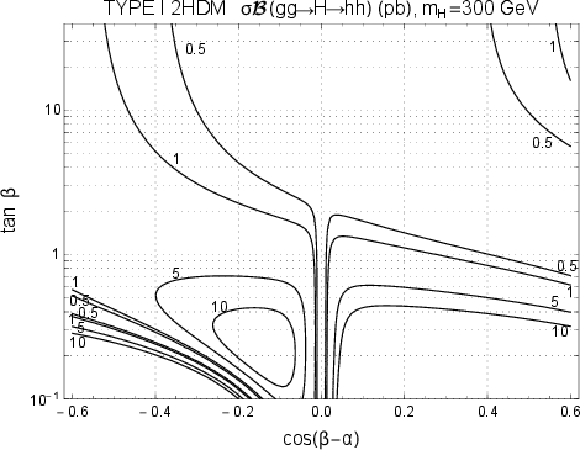
png pdf |
Figure 6-b:
a,c: observed and expected 95% CL upper limits for gluon fusion production of a heavy Higgs boson $ {\mathrm {H}} $ of mass 300 GeV as a function of parameters $\tan\beta $ and $\cos(\beta - \alpha )$ of the Type I (a) and II (c) 2HDM. The parameters determine the $ {\mathrm {H}} $ production cross section as well as the branching fractions $\mathcal {B}( {\mathrm {H}} \to {\mathrm {h}} {\mathrm {h}} )$ and $\mathcal {B}( {\mathrm {h}} \to {\mathrm {W}} {\mathrm {W}}^*, {\mathrm {Z}} {\mathrm {Z}}^*, {\tau } {\tau }, \gamma \gamma )$, which are relevant to this search. b,d: the $\sigma \mathcal {B}( {\mathrm {H}} \to {\mathrm {h}} {\mathrm {h}} )$ contours for Type I (b) and II (d) 2HDM adopted from Ref.[35]. The excluded regions are either below the open limit contours or within the closed ones. |

png pdf |
Figure 6-c:
a,c: observed and expected 95% CL upper limits for gluon fusion production of a heavy Higgs boson $ {\mathrm {H}} $ of mass 300 GeV as a function of parameters $\tan\beta $ and $\cos(\beta - \alpha )$ of the Type I (a) and II (c) 2HDM. The parameters determine the $ {\mathrm {H}} $ production cross section as well as the branching fractions $\mathcal {B}( {\mathrm {H}} \to {\mathrm {h}} {\mathrm {h}} )$ and $\mathcal {B}( {\mathrm {h}} \to {\mathrm {W}} {\mathrm {W}}^*, {\mathrm {Z}} {\mathrm {Z}}^*, {\tau } {\tau }, \gamma \gamma )$, which are relevant to this search. b,d: the $\sigma \mathcal {B}( {\mathrm {H}} \to {\mathrm {h}} {\mathrm {h}} )$ contours for Type I (b) and II (d) 2HDM adopted from Ref.[35]. The excluded regions are either below the open limit contours or within the closed ones. |
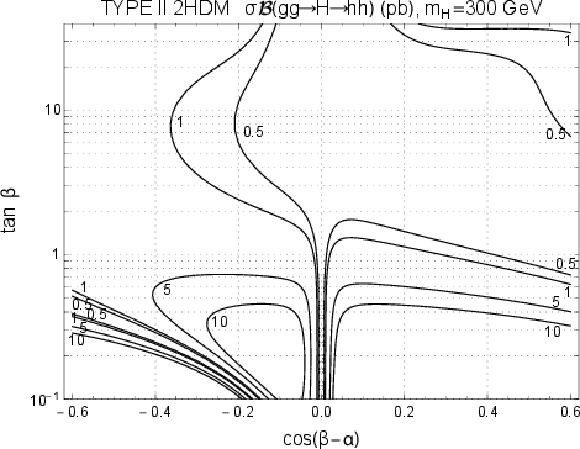
png pdf |
Figure 6-d:
a,c: observed and expected 95% CL upper limits for gluon fusion production of a heavy Higgs boson $ {\mathrm {H}} $ of mass 300 GeV as a function of parameters $\tan\beta $ and $\cos(\beta - \alpha )$ of the Type I (a) and II (c) 2HDM. The parameters determine the $ {\mathrm {H}} $ production cross section as well as the branching fractions $\mathcal {B}( {\mathrm {H}} \to {\mathrm {h}} {\mathrm {h}} )$ and $\mathcal {B}( {\mathrm {h}} \to {\mathrm {W}} {\mathrm {W}}^*, {\mathrm {Z}} {\mathrm {Z}}^*, {\tau } {\tau }, \gamma \gamma )$, which are relevant to this search. b,d: the $\sigma \mathcal {B}( {\mathrm {H}} \to {\mathrm {h}} {\mathrm {h}} )$ contours for Type I (b) and II (d) 2HDM adopted from Ref.[35]. The excluded regions are either below the open limit contours or within the closed ones. |
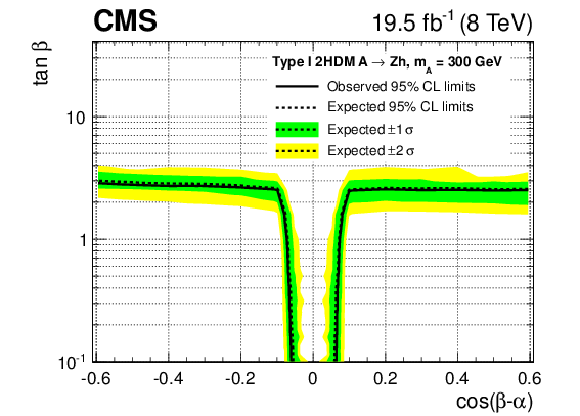
png pdf |
Figure 7-a:
a,c: observed and expected 95% CL upper limits for gluon fusion production of an $ {\mathrm {A}} $ boson of mass 300 GeV as a function of parameters $\qopname \relax o{tan}\beta $ and $\cos(\beta - \alpha )$ of the Type I (a) and II (c) 2HDM. The parameters determine the $ {\mathrm {A}} $ production cross section as well as the branching fractions $\mathcal {B}( {\mathrm {A}} \to {\mathrm {Z}} {\mathrm {h}} )$ and $\mathcal {B}( {\mathrm {h}} \to {\mathrm {W}} {\mathrm {W}}^*, {\mathrm {Z}} {\mathrm {Z}}^*, {\tau } {\tau }, \gamma \gamma )$ which are relevant to this search. b,d: the $\sigma \mathcal {B}( {\mathrm {A}} \to {\mathrm {Z}} {\mathrm {h}} )$ contours for Type I (b) and II (d) 2HDM adopted from Ref. [35]. The excluded regions are below the open limit contours. |

png pdf |
Figure 7-b:
a,c: observed and expected 95% CL upper limits for gluon fusion production of an $ {\mathrm {A}} $ boson of mass 300 GeV as a function of parameters $\qopname \relax o{tan}\beta $ and $\cos(\beta - \alpha )$ of the Type I (a) and II (c) 2HDM. The parameters determine the $ {\mathrm {A}} $ production cross section as well as the branching fractions $\mathcal {B}( {\mathrm {A}} \to {\mathrm {Z}} {\mathrm {h}} )$ and $\mathcal {B}( {\mathrm {h}} \to {\mathrm {W}} {\mathrm {W}}^*, {\mathrm {Z}} {\mathrm {Z}}^*, {\tau } {\tau }, \gamma \gamma )$ which are relevant to this search. b,d: the $\sigma \mathcal {B}( {\mathrm {A}} \to {\mathrm {Z}} {\mathrm {h}} )$ contours for Type I (b) and II (d) 2HDM adopted from Ref. [35]. The excluded regions are below the open limit contours. |

png pdf |
Figure 7-c:
a,c: observed and expected 95% CL upper limits for gluon fusion production of an $ {\mathrm {A}} $ boson of mass 300 GeV as a function of parameters $\qopname \relax o{tan}\beta $ and $\cos(\beta - \alpha )$ of the Type I (a) and II (c) 2HDM. The parameters determine the $ {\mathrm {A}} $ production cross section as well as the branching fractions $\mathcal {B}( {\mathrm {A}} \to {\mathrm {Z}} {\mathrm {h}} )$ and $\mathcal {B}( {\mathrm {h}} \to {\mathrm {W}} {\mathrm {W}}^*, {\mathrm {Z}} {\mathrm {Z}}^*, {\tau } {\tau }, \gamma \gamma )$ which are relevant to this search. b,d: the $\sigma \mathcal {B}( {\mathrm {A}} \to {\mathrm {Z}} {\mathrm {h}} )$ contours for Type I (b) and II (d) 2HDM adopted from Ref. [35]. The excluded regions are below the open limit contours. |
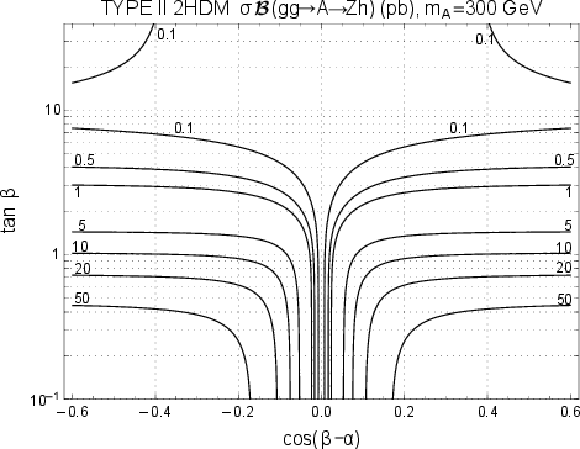
png pdf |
Figure 7-d:
a,c: observed and expected 95% CL upper limits for gluon fusion production of an $ {\mathrm {A}} $ boson of mass 300 GeV as a function of parameters $\qopname \relax o{tan}\beta $ and $\cos(\beta - \alpha )$ of the Type I (a) and II (c) 2HDM. The parameters determine the $ {\mathrm {A}} $ production cross section as well as the branching fractions $\mathcal {B}( {\mathrm {A}} \to {\mathrm {Z}} {\mathrm {h}} )$ and $\mathcal {B}( {\mathrm {h}} \to {\mathrm {W}} {\mathrm {W}}^*, {\mathrm {Z}} {\mathrm {Z}}^*, {\tau } {\tau }, \gamma \gamma )$ which are relevant to this search. b,d: the $\sigma \mathcal {B}( {\mathrm {A}} \to {\mathrm {Z}} {\mathrm {h}} )$ contours for Type I (b) and II (d) 2HDM adopted from Ref. [35]. The excluded regions are below the open limit contours. |
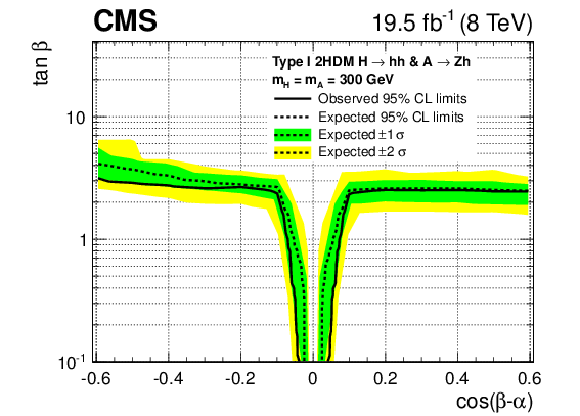
png pdf |
Figure 8-a:
Combined observed and expected 95% upper limits for gluon fusion production of a heavy Higgs boson $ {\mathrm {H}} $ and $ {\mathrm {A}} $ of mass 300 GeV for Type I (left) and Type II(right) 2HDM as a function of parameters $\tan\beta $ and $\cos(\beta - \alpha )$. The parameters determine the $ {\mathrm {H}} $ and $ {\mathrm {A}} $ production cross sections as well as the branching fractions $\mathcal {B}( {\mathrm {H}} \to {\mathrm {h}} {\mathrm {h}} )$, $\mathcal {B}( {\mathrm {A}} \to {\mathrm {Z}} {\mathrm {h}} )$, and $\mathcal {B}( {\mathrm {h}} \to {\mathrm {W}} {\mathrm {W}}^*, {\mathrm {Z}} {\mathrm {Z}}^*, {\tau } {\tau }, \gamma \gamma )$, which are relevant to this search. |

png pdf |
Figure 8-b:
Combined observed and expected 95% upper limits for gluon fusion production of a heavy Higgs boson $ {\mathrm {H}} $ and $ {\mathrm {A}} $ of mass 300 GeV for Type I (left) and Type II(right) 2HDM as a function of parameters $\tan\beta $ and $\cos(\beta - \alpha )$. The parameters determine the $ {\mathrm {H}} $ and $ {\mathrm {A}} $ production cross sections as well as the branching fractions $\mathcal {B}( {\mathrm {H}} \to {\mathrm {h}} {\mathrm {h}} )$, $\mathcal {B}( {\mathrm {A}} \to {\mathrm {Z}} {\mathrm {h}} )$, and $\mathcal {B}( {\mathrm {h}} \to {\mathrm {W}} {\mathrm {W}}^*, {\mathrm {Z}} {\mathrm {Z}}^*, {\tau } {\tau }, \gamma \gamma )$, which are relevant to this search. |
| Tables | |

png pdf |
Table 1:
Observed (Obs.) yields and SM expectations (Exp.) for three-lepton events. See text for the description of event classification by the number and invariant mass of opposite-sign, same-flavor lepton pairs that are on- or below-$ {\mathrm {Z}}$ (see Section 4.2), presence of $ { {\tau }_\mathrm {h}} $, tagged $ {\mathrm {b}}$ jets, and the $ {E_{\mathrm {T}}^{\text {miss}}} $ in the event. The 70 channels are exclusive. |

png pdf |
Table 2:
Observed (Obs.) yields and SM expectation (Exp.) for four-lepton events. See text for the description of event classification by the number and invariant mass of opposite-sign, same-flavor lepton pairs that are on- or off-$ {\mathrm {Z}}$, presence of $ { {\tau }_\mathrm {h}} $, tagged $ {\mathrm {b}}$ jets, and the total $ {E_{\mathrm {T}}^{\text {miss}}} $ in the event. The 72 channels are exclusive. |
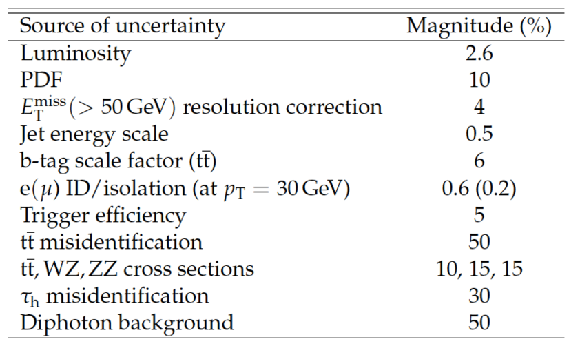
png pdf |
Table 3:
A compilation of significant sources of systematic uncertainties in the event yield estimation. Note that a given uncertainty may pertain only to specific sources of background. The listed values are representative and the impact of an uncertainty varies from search channel to channel. |
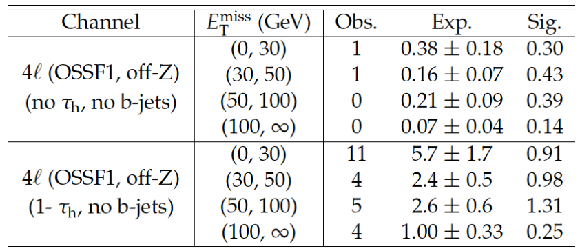
png pdf |
Table 4:
Observed (Obs.) yields and SM expectation (Exp.) for selected four-lepton channels in the $ {\mathrm {H}} \to {\mathrm {h}} {\mathrm {h}} $ search. These are also shown in Fig. 2. See text for the description of event classification. The $ {\mathrm {H}} \to {\mathrm {h}} {\mathrm {h}} $ signal (Sig.) is also listed, assuming $\sigma \mathcal {B}( {\mathrm {p}} {\mathrm {p}}\to {\mathrm {H}} \to {\mathrm {h}} {\mathrm {h}} ) =$ 3.59 pb. |

png pdf |
Table 5:
Observed (Obs.) yields and SM expectation (Exp.) for selected four-lepton channels in the $ {\mathrm {A}} \to {\mathrm {Z}} {\mathrm {h}} $ search. These are also shown in Fig. 3. See text for the description of event classification. The $ {\mathrm {A}} \to {\mathrm {Z}} {\mathrm {h}} $ signal (Sig.) is also listed, assuming $\sigma \mathcal {B}( {\mathrm {p}} {\mathrm {p}}\to {\mathrm {A}} \to {\mathrm {Z}} {\mathrm {h}} ) =$ 3.59 pb. |
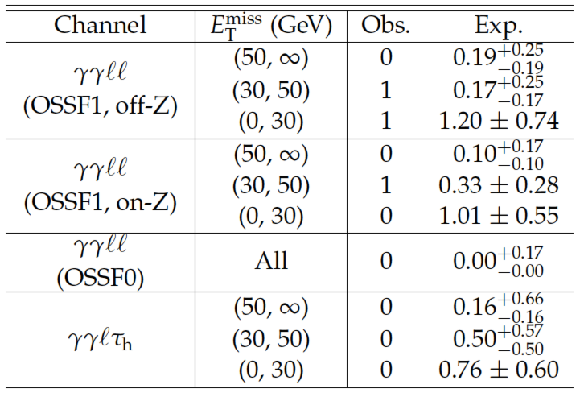
png pdf |
Table 6:
Observed yields and SM expectations for dilepton+diphoton events. The diphoton invariant mass is required to be in the 120--130 GeV window. The ten channels are exclusive. |

png pdf |
Table 7:
Observed yields and SM expectations for single lepton+diphoton events. The diphoton invariant mass is required to be in the 120--130 GeV window. The eight channels are exclusive. |

png pdf |
Table 8:
The ten most sensitive search channels for $ {\mathrm {t}}\to {\mathrm {c}} {\mathrm {h}} $, along with the number of observed(Obs.), expected SM background(Exp.), and expected signal(Sig.) events (assuming $\mathcal {B}( {\mathrm {t}}\to {\mathrm {c}} {\mathrm {h}} ) = 1%$). The three-lepton channels are taken from Ref.[9], have $ {H_{\mathrm {T}}} <$ 200 GeV and do not contain a $ { {\tau }_\mathrm {h}} $. The stated uncertainties contain both systematic and statistical components. |

png pdf |
Table 9:
Comparison of the observed and expected 95% CL limits on $\mathcal {B}( {\mathrm {t}}\to {\mathrm {c}} {\mathrm {h}} )$ from individual Higgs boson decay modes along with the 68% CL uncertainty ranges. |
| Summary |
| We have performed a search for the $\mathrm{ H \to hh } $ and $ \mathrm {A \to Zh}$ decays of heavy scalar (H) and pseudoscalar (A) Higgs bosons, respectively, which occur in the extended Higgs sector described by the 2HDM. This is the first search for these decays carried out at the LHC.We used multilepton and diphoton final states from a dataset corresponding to an integrated luminosity of 19.5 fb$^{-1}$ of data recorded in 2012 from pp collisions at a center-of-mass energy of 8 TeV. We find no significant deviation from the SM expectations and place 95% CL cross section upper limits of approximately 7 pb on $\sigma \times \mathcal{B}$ for $\mathrm{ H \to hh }$ and 2 pb for $ \mathrm{ A \to Zh }$. We further interpret these limits in the context of Type I and Type II 2HDMs, presenting exclusion contours in the $ \tan \beta$ versus $ \cos ( \beta - \alpha ) $ plane. Using diphoton and multilepton search channels that are sensitive to the decay $\mathrm{ t \to ch }$, we place an upper limit of 0.56% on $ \mathcal{B}(\mathrm{ t \to ch}) $, where the expected limit is 0.65%. This is a significant improvement over the earlier limit of 1.3% from the multilepton search alone. |

|
Compact Muon Solenoid LHC, CERN |

|

|

|

|

|

|